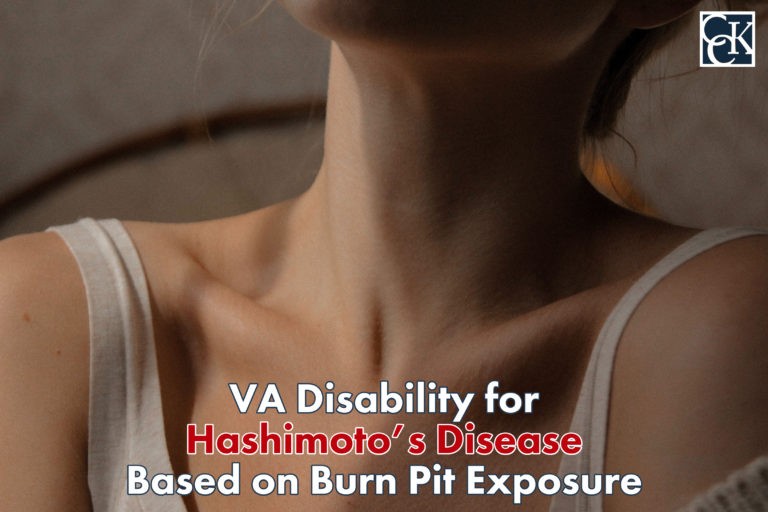VA Disability for Hashimoto’s Disease: Burn Pit Exposure

What is Hashimoto’s Disease?
Hashimoto’s disease, or Hashimoto’s thyroiditis, is the most common cause of hypothyroidism in the United States. The condition is also referred to as chronic lymphocytic thyroiditis. Hashimoto’s disease is an autoimmune disorder where the thyroid is chronically inflamed. The condition can be genetic, meaning it often runs in families.
Over time, the thyroid gland can weaken, which may impair the production of thyroid hormones. This could lead to a decrease in thyroid function, or hypothyroidism. The condition may affect any age group, but most commonly affects middle-aged women.
Symptoms of Hashimoto’s Disease
- Swelling in the throat, or the appearance of a goiter
- Swelling in the face
- Swelling of the tongue
- Weight gain
- Exhaustion, fatigue, or sluggishness
- Muscle weakness
- Joint pain or stiffness
- Constipation
- Infertility or miscarriage
- Decreased libido
- Increased menstrual bleeding
- Hair loss
- Dry or discolored, pale skin
- Increased sensitivity to cold
Complications that Can Arise from Hashimoto’s Disease
- Goiters
- Heart problems, including heart failure
- Depression, memory loss, or other mental health conditions
- Birth defects in babies born to mothers with hypothyroidism, as well as an increased risk of stillborn or premature births
- Myxedema coma, a form of coma that can be caused by untreated hypothyroidism
Treating Hashimoto’s Disease
Importantly, having Hashimoto’s disease does not automatically mean a person has hypothyroidism. To diagnose Hashimoto’s disease, a doctor may perform a physical examination and blood tests. These blood tests can measure a person’s hormone levels and determine how effectively the thyroid is functioning.
Three tests may be performed to test the thyroid: TSH test, free T4 and total T3 test, and the thyroid peroxidase antibody test. These tests can also determine what course of treatment should be taken. For example, if the tests reveal low thyroid hormone levels, then a doctor may prescribe thyroid hormone replacement therapy. Another treatment could be a kind of medicine called levothyroxine, a daily pill that can help regulate thyroid function and thyroid hormone levels.
VA Disability Benefits Ratings for Hashimoto’s Disease
Though not the same as hypothyroidism, Hashimoto’s disease is rated under Diagnostic Code 7903, the same diagnostic code used to rate hypothyroidism. The rating criteria for Hashimoto’s disease, which are based on the symptoms of hypothyroidism, are listed below:
- 10%–The veteran has symptoms of fatigability or continuous medicated is required to control the veteran’s symptoms.
- 30%–The veteran has symptoms of fatigue, constipation, and mental sluggishness.
- 60%–The veteran has symptoms of muscular weakness, mental disturbance, and weight gain.
- 100%– The veteran has symptoms such as cold intolerance, muscular weakness, cardiovascular involvement, mental disturbance (such as dementia, slowing of thought, or depression), bradycardia (less than 60 beats per minute), and sleepiness.
Compensation and Pension (C&P) Exams for Hashimoto’s Disease
When a veteran files a claim for Hashimoto’s disease, VA may request a Compensation and Pension exam, or C&P exam. To request an exam, VA may send the veteran a letter or call them. It is important to follow through with scheduling and attending this exam, otherwise, VA could deny the veteran’s claim.
The exam will usually be performed by a VA physician or a VA contracted physician. Before the exam, the examiner will review the veteran’s c-file. This will contain any documentation that has previously been submitted to VA, as well as the veteran’s medical and service records.
The veteran may also use a DBQ, or Disability Benefits Questionnaire, to bolster their claim. A Disability Benefits Questionnaire is a form created by the VA so that the veteran may address important aspects of their condition, such as symptoms, severity, possible causes, and relation to other disabilities. The veteran may also have their private doctor fill out a DBQ on their behalf. A private doctor who treats the veteran’s Hashimoto’s disease may be able to provide VA with more insight into the veteran’s condition.
Burn Pits and Hashimoto’s Disease
Veterans who served in the post-9/11 era may have been exposed to toxins emitted by military burn pits that were used during this time period. As a result of this exposure, many veterans have developed Hashimoto’s disease, as well as hypothyroidism in some cases.
What are Military Burn Pits?
Military burn pits are large areas of land where waste was incinerated by the military and its contractors. The United States Military used burn pits as part of its waste disposal protocol in places such as Iraq and Afghanistan in the post-9/11 era. The practice was effective in reducing large quantities of waste, but the pits emitted plumes of toxic smoke. The following materials have been linked to military burn pits:
- Human waste
- Medical waste
- Ammunition
- Paint
- Plastic
- Rubber
- Styrofoam
- Other toxic chemicals
- Spoiled food
- Lubricants
- Petroleum
What Conditions Have Been Linked to Burn Pits?
The following conditions have been linked to burn pit exposure as of the 2022 PACT Act:
- Asthma diagnosed after service
- Head cancer (of any type)
- Neck cancer (of any type)
- Respiratory cancer (of any type)
- Gastrointestinal cancer (of any type)
- Reproductive cancer (of any type)
- Lymphoma cancer (of any type)
- Lymphomatic cancer (of any type)
- Kidney cancer
- Brain cancer
- Melanoma
- Pancreatic cancer
- Chronic bronchitis
- COPD
- Constrictive bronchiolitis or obliterative bronchiolitis
- Emphysema
- Granulomatous disease
- Interstitial lung disease
- Pleuritis
- Pulmonary fibrosis
- Sarcoidosis
- Chronic sinusitis
- Chronic rhinitis
- Glioblastoma

Agent Orange, Hypothyroidism, and Hashimoto’s Disease
In 2021, the National Defense Authorization Act added hypothyroidism, and two other conditions, to the list of presumptive conditions for which VA grants service connection for veterans who were exposed to Agent Orange during their service. Specifically, in order to be eligible for presumptive service connection for hypothyroidism, the veteran needs to have active military, naval, air, or space service in the following locations and time periods:
- The Republic of Vietnam from January 9, 1962 to May 7, 1975;
- Thailand, at any US or Thai base, from January 9, 1962 to June 30 1976, without regard to the Veteran’s MOS or where on base they were located;
- Laos from December 1, 1965 to September 30, 1969;
- Cambodia, specifically at Mimot or Krek, Kampong Cham Province from April 16, 1969 to April 30, 1969;
- Guam or American Samoa or in the territorial waters thereof from January 9, 1962 to July 30, 1980;
- Johnson Atoll or a ship that called at Johnston Atoll from January 1, 1972 to September 30, 1977.
Essentially, the addition of hypothyroidism to the list means that veterans do not have to prove a medical nexus between their condition and their military service.
What Is Agent Orange?
During the Vietnam War, the United States used several herbicides to destroy its enemy’s crops. The goal was to interrupt their food supply and destroy foliage in the jungle to increase visibility and prevent ambush attacks.
Among these chemical agents, and perhaps the most well-known of the “rainbow herbicides” used during the Vietnam War, was an herbicide called Agent Orange. Agent Orange contained a mixture of two kinds of herbicide agents (i.e., 2,4-D and 2,4,5-T). However, as a byproduct of its production, it also contained the highly toxic dioxin contaminant 2,3,7,8-TCDD.
As a result of this dioxin contaminant, many veterans who were exposed to Agent Orange have developed serious health conditions. Hypothyroidism is one of these conditions.
The Link between Agent Orange and Burn Pits
Exposure to burns pits has also been associated with exposure to particulate matter and dioxins. Particulate matter can be particularly harmful when it enters the bloodstream or the lungs and has been associated with chronic respiratory conditions.
The main dioxin released by burn pits is called TCDD and was also one of the major toxins in Agent Orange. TCDD has been linked to various cancers and other serious disabilities.
While veterans with Hashimoto’s Disease may be able to receive presumptive service connection if they are veterans of the Vietnam War era, there is no presumption of service connection for veterans with exposure stemming from burn pits. This can make it difficult for veterans with Hashimoto’s disease resulting for exposure to burn pits to secure VA disability benefits.
TDIU and Hashimoto’s Disease
Veterans who are prevented from working because of their Hashimoto’s disease may be able to receive a monthly VA disability benefit called total disability based on individual unemployability, or TDIU. This benefit compensates veterans at the 100 percent rating level, even if their disability rating may be less than that.
There are generally two pathways to prove eligibility for TDIU:
- 38 CFR § 4.16a (“Schedular”) – For this form of TDIU, the veteran must have:
- One condition rated at minimum 60 percent OR two conditions that can be combined to reach 70 percent, where one condition is at minimum 40 percent
- 38 CFR § 4.16b (“Extraschedular”) – This form of TDIU is for veterans who may not be able to achieve the ratings necessary for schedular TDIU but are still unable to obtain substantially gainful employment on account of their conditions.
- In this instance, the veteran must prove that their condition hinders their ability to obtain substantially gainful employment and therefore should not be rated on the standard disability rating criteria.
Veterans who may not have a 100 percent rating for their Hashimoto’s disease may be able to receive compensation at the 100 percent rating level through TDIU.
Getting Assistance with VA Disability Benefits for Hashimoto’s Disease
As Hashimoto’s disease is currently not a presumptive condition for military burn pit exposure, it can be difficult to become service-connected for this condition. This can lead to much frustration for veterans seeking VA disability benefits for their condition. Additionally, the way in which VA rates Hashimoto’s disease can seem complicated and hard to differentiate from hypothyroidism.
A VA accredited lawyer or representative can be helpful for veterans trying to navigate VA law for their Hashimoto’s disease. If you need assistance filing an initial claim or appealing a denial of VA disability benefits for Hashimoto’s disease, the VA disability lawyers at Chisholm Chisholm & Kilpatrick may be able to help. Contact us at 800-544-9144 for a free consultation with our office.
About the Author
Share this Post

